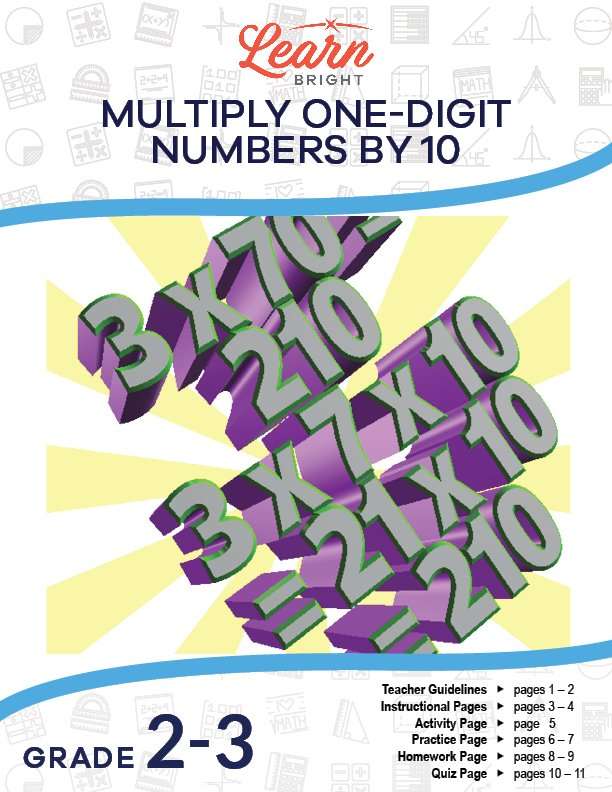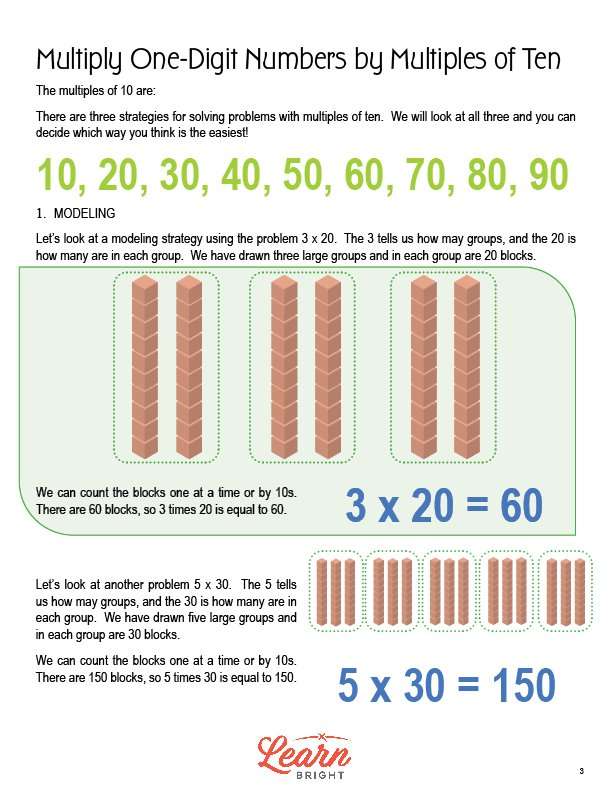Description
What our Multiply One-Digit Numbers by 10 lesson plan includes
Lesson Objectives and Overview: Multiply One-Digit Numbers by 10 explains three different methods that can be used to multiply single-digit numbers by ten. The strategies are modeling, repeated addition and the zero trick. Each strategy is presented with examples for the teacher to demonstrate for students. At the end of the lesson, students will be able to multiply one-digit whole numbers by multiples of ten from 10 to 90. This lesson is for students in 2nd grade and 3rd grade.
Classroom Procedure
Every lesson plan provides you with a classroom procedure page that outlines a step-by-step guide to follow. You do not have to follow the guide exactly. The guide helps you organize the lesson and details when to hand out worksheets. It also lists information in the blue box that you might find useful. You will find the lesson objectives, state standards, and number of class sessions the lesson should take to complete in this area. In addition, it describes the supplies you will need as well as what and how you need to prepare beforehand.
Options for Lesson
Included with this lesson is an “Options for Lesson” section that lists a number of suggestions for activities to add to the lesson or substitutions for the ones already in the lesson. One optional adjustment to the lesson activity is to have your students use dice to come up with their numbers instead of cards. For an additional activity, you could have your students make a poster of a problem showing all three strategies for solving the problems. You could also have your students solve problems as fast as they can in a race against another student.
Teacher Notes
The teacher notes page includes lines that you can use to add your own notes as you’re preparing for this lesson.
MULTIPLY ONE-DIGIT NUMBERS BY 10 LESSON PLAN CONTENT PAGES
Multiply One-Digit Numbers by Multiples of Ten
The Multiply One-Digit Numbers by 10 lesson plan includes two content pages. The multiples of 10 are 10, 20, 30, 40, 50, 60, 70, 80, and 90. We have three strategies for solving problems with multiples of 10. It’s good to learn all three strategies, but you can use whichever one you like best!
Modeling
The first strategy is modeling. For the problem 3 x 20, the 3 tells us how many groups we need and the 20 is how many are in each group. To show this as a model, we can draw three large groups with 20 blocks each. To solve, we can either count the blocks one at a time or by 10s. When we count using the model, we discover that there are 60 blocks. Therefore, 3 x 20 = 60.
For the problem 5 x 30, we follow the same steps. The 5 tells us how many groups we need and the 30 is how many are in each group. To show this as a model, we draw five large groups with 30 blocks each. We then count the blocks one at a time or by 10s. When we count, we discover that there are 150 blocks. Therefore, 5 x 30 = 150.
Repeated Addition
The second strategy is repeated addition. For the problem 4 x 30, the 4 tells us how many times to add 30. To solve, we add 30 four times: 30 + 30 + 30 + 30 = 120. Therefore, 4 x 30 = 120.
For the problem 3 x 80, the 3 tells us how many times to add 80. To solve, we add 80 three times: 80 + 80 + 80 = 240. Therefore, 3 x 80 = 240.
The Zero Trick
The third strategy is the zero trick. For the problem 3 x 70, we multiply the 3 and 7 together and then add the zero on at the end: 3 x 7 = 21, so 3 x 70 = 210. We can also think of this as 3 x 7 x 10 = 21 x 10 = 210.
You can often use this strategy to use mental math to solve. Just make sure you know your multiplication facts!
MULTIPLY ONE-DIGIT NUMBERS BY 10 LESSON PLAN WORKSHEETS
The Multiply One-Digit Numbers by 10 lesson plan includes four worksheets: an activity worksheet, a practice worksheet, a homework assignment, and a quiz. You can refer to the guide on the classroom procedure page to determine when to hand out each worksheet.
CARDS ACTIVITY WORKSHEET
For the activity worksheet, students will flip over cards from a deck of cards and record the numbers in the blanks on the worksheet. They will then solve each problem using any strategy.
MODELS, REPEATED ADDITION, AND ZERO TRICK PRACTICE WORKSHEET
The practice worksheet asks students to complete three short exercises. For the first, they will look at pictures and write down what multiplication problem is being modeled in the pictures. For the second, they will use repeated addition to find the answers to four multiplication problems. Finally, for the third, they will find the answer to nine multiplication problems using the zero trick.
MULTIPLY ONE-DIGIT NUMBERS BY 10 HOMEWORK ASSIGNMENT
Like the practice worksheet, the homework assignment asks students to complete three short exercises. For the first, they will look at pictures and write down what multiplication problem is being modeled in the pictures. For the second, they will use repeated addition to find the answers to four multiplication problems. Finally, for the third, they will find the answer to nine multiplication problems using the zero trick.
QUIZ
This lesson also includes a quiz that you can use to test students’ understanding of the lesson material. For the quiz, students will show how to solve the problem 5 x 20 using the three strategies covered in the lesson: modeling, repeated addition, and the zero trick.
Worksheet Answer Keys
This lesson plan includes answer keys for the practice worksheet, the homework assignment, and the quiz. If you choose to administer the lesson pages to your students via PDF, you will need to save a new file that omits these pages. Otherwise, you can simply print out the applicable pages and keep these as reference for yourself when grading assignments.









